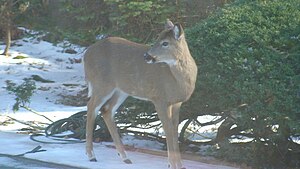 |
| (Photo credit: Wikipedia) |
As part of an initiative to update maps of deer wintering complexes (also known as "deer yards") in the Upper Peninsula, the Michigan Department of Natural Resources is seeking help from the public to identify locations where deer are concentrating this winter.
During the snowy winter months, deer in some areas of the Upper Peninsula traditionally migrate to areas that possess an abundance of conifer trees, especially cedar and hemlock. Cedar and hemlock provide an excellent source of food, while their branches intercept snow and serve to shelter deer from deep snowfall.
The reduced snow depth in deer yards results in deer expending less energy moving between feeding and shelter areas. In addition, the conifer cover acts to insulate the deer by reducing wind movement and providing higher nighttime temperatures. Because deer have a more restricted and lower quality diet in the winter compared to other times of the year, it is imperative that they find ways to conserve energy stores.
“We are updating our maps of where deer are spending their time during the winter. This is an effort to ensure wildlife biologists and foresters have the best available information when making decisions about conservation and sustainable management of deer wintering complexes,” said DNR wildlife biologist Bob Doepker.
DNR field staff will be verifying the presence of deer and clarifying the deer wintering complex boundaries during the winter months. Assistance from the public in providing the locations where deer concentrate in the winter will dramatically increase the number of locations that can be checked by field staff to refine deer wintering complex boundaries.
Deer observation forms can be downloaded from the DNR’s website by going towww.michigan.gov/deer and clicking on the “Upper Peninsula Winter Deer Observations” link. Hardcopies are also available at DNR offices in the Upper Peninsula (for office locations, visitwww.michigan.gov/contactdnr).
Completed observation forms should be returned to: Michigan DNR, Wildlife Division, Norway Field Office, 520 W. US Hwy. 2, Norway, MI 49870.
For more information about the project, contact Bob Doepker or Steve Carson at 906-563-9247.


No comments:
Post a Comment